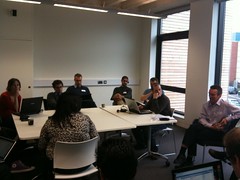Why do so many councils have such a poor online presence? I’ve written before about some of the missed opportunities, such as here, but for me the puzzle is as much “what should a council do?” as “why don’t more of them do it?”
Part of the explanation, at least from the councillor side, is average age. Councillors are on average near retirement (58.3 in 2006), which means not many have either grown up with the modern internet age or worked in firms created by it.
The challenge then for the typical older councillor is to have enough knowledge to know what their council could or should be doing and to have some idea of whether or not its staff and contractors are doing a good job.
In some areas councillors are usually good at this; for example, councillors are often intensive email users and well placed to tell whether or not an email system is up to scratch.
Search engine optimisation is an area at the other end of the spectrum – often over-looked by councillors and often not done well by councils. So what does a councillor need to know?
What is search engine optimisation (SEO)?
SEO means a bundle of work in order to make a particular website come out near or at the top of search results when someone is using Google or another search engine.
Why does SEO matter?
For councils, it matters for two primary reasons. First, people often use Google as their jumping off point to find information. With search results, almost no-one clicks on results that don’t come up on the first page, and even on the first page the number of people who click on a search result declines rapidly as you move down the page. So if you’re not on the first page you miss out on getting people coming to your website.
Second, councils often provide information that the public don’t immediately associate with the council. Tips on how to live a greener lifestyle are a good example, Many councils put a lot of effort in to publicising this sort of information, but most online members of the public won’t think, “I’ll see what the council has to say about saving on my electricity bills”. Instead, they go to Google and look for information generally. If you want the council information to be found and used, it has to come up high in the search results.
What does SEO involve?
Most SEO work falls into a research phase and then three areas of activity.
The research phase involves working out what the key information is that the website wants to get over (e.g. recycling information) and then the phrases that the public use when searching for such information (e.g. do people talk about “waste” or “rubbish” or “refuse” when looking for such information?). Firms such as Google provide very detailed information about people’s aggregate search habits for free, so the end result of this search should be a specific list of topics and terms which the website needs to perform well on.
Tip one for councillors: ask to see the list of terms the site is being optimised for. If it doesn’t exist, then either the website team is neglecting SEO or they are doing it poorly. The list may be informally in several people’s heads, on a post-it note or in an email somewhere. So you may need to add some extra judgement about how methodical the work has been and whether that suits the size of council and the budget given to online matters.
The three areas of work then are technical, copy and outreach.
Technical works means the way web pages are coded and the content on them marked up. Some ways of producing web pages are liked by search engines, other ways hide their content from them. This is perhaps the hardest area for a non-technical person to judge. My to three tips, based on what is most often got wrong if people aren’t thinking SEO, are:
- Look at the photos and see whether they have any “alt” text set (this is the text that appears if you hover over the photo or right click on it, depending on your web browser)
- Are the headlines on the page marked up with H1 HTML tags? Don’t worry if you don’t know how to check this; it’s pretty easy to do, so just ask someone who is a bit familiar with creating websites!
- Do the web addresses for individual pages contain real words or are they long technical strings? E.g. www.MyCouncil.org.uk/655804231 will do less well in searches for recycling than www.MyCouncil.org.uk/recycling-news/update
The next area of SEO work is copy: does the text on the site regularly and prominently use the key words and phrases identified from the research? Pages should still read naturally, but they can be written in a way that uses the key terms more rather than less.
The third area is outreach, or “link building”, i.e. getting other websites to link through to yours. The more links you have, the better the site does in searches – though to stop abuse, search engines give more importance to links from well respected other sites. External tools can be a bit hit and miss in the number of links they list, but try going to Google and search for link:www.Islington.gov.uk changing “Islington” to your council. You can then do this for several other similar councils and see how the total number of links Google lists compares.
Improving SEO
Checking these areas should give a councillor a good idea of whether their website team is on the ball at SEO, doing it poorly or just ignoring it. Based on that, an appropriate follow-up at the senior level with council staff can be made.
Senior council staff may or may not understand SEO too! But with these answers both sides of that conversation will know whether more detailed follow up is needed down through the organisation – and how to judge whether any follow up really produces results.
Good luck!
Mark Pack worked for the Liberal Democrats 2000-2009, ending up as their Head of Innovations. During that time he often trained councillors on how to make better use of the internet. He’s now at Mandate Communications (
www.YourMandate.com) and blogs about politics, history and technology at
www.MarkPack.org.uk. He’s on Twitter at
@markpack.




